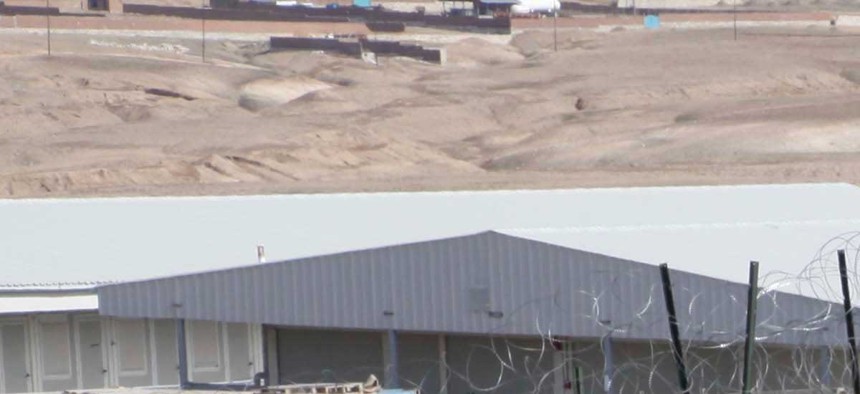
Patrolmen with the Provincial Response Company, Task Unit Wardak, prepare for a humanitarian assistance patrol at Forward Operating Base Airborne, Wardak province, on March 27, 2014. U.S. Army photo by Cpl. George Huley
As the Army’s Future Takes Shape, So Does the Defense Market
As tens of thousands descend on Washington for the annual Association of the United States Army convention, competition for Army business is heating up. By Marcus Weisgerber
For two years, the U.S. Army has been pitching new ways it could stay relevant and play a more prominent role in the Pentagon’s pivot to the Pacific, a region where the Navy and Air Force are expected to play a more prominent role. Now, after a turbulent year in which Russia invaded Ukraine over land and Army soldiers have deployed on high-profile missions to Iraq and Africa, there is a wider-spread recognition that the ground service will have a significant role to play after Afghanistan.
But despite this resurgence in missions, that doesn’t mean work will be easy to come by for defense companies. Defense firms descend on Washington this week for the Association of the United States Army, or AUSA, annual convention and arms exposition. This year’s gathering comes after the Army announced major changes to its makeup, including cutting tens of thousands of soldiers from its ranks. But it lands right when a leader like Army Chief of Staff Gen. Ray Odierno has signaled he will revisit those plans to shrink the force—and the budget—thanks to ISIS and Russia.
“Reports of my death have been greatly exaggerated,” said Byron Callan, an analyst with Capital Alpha Partners, channeling his inner Mark Twain. “Maybe you could say the same thing about the Army.”
President Barack Obama created training and advising missions for more than 1,000 soldiers in Iraq following the spread of Islamic State, or ISIS, militants stretching across the border into Syria. The Army also deployed Apache helicopters to combat the group in a campaign that U.S. leaders said could last years. Meanwhile, up to 4,000 soldiers could assist in helping contain the Ebola outbreak across Western Africa. Additionally, NATO is planning for increased rotational deployments to Eastern Europe.
The Army had scaled back or canceled major weapons programs in an effort to keep the remaining force properly trained and prepared to fight should a conflict arise. A smaller budget, combined with fewer soldiers, meant fewer acquisition projects and scaling back of ones on the books.
These cuts, experts say, still could change the landscape of the defense companies—many which have vastly expanded during more than decade of war in Afghanistan and Iraq—who heavily rely on Army business.
Firms that can build smaller quantities of items more efficiently will be successful down the road, experts say.
Last decade, the defense industry, specifically in the Army sector, expanded rapidly during the wars in Iraq and Afghanistan. Now as these major ground conflicts come to a close, the Army’s budget is contracting just as fast as it expanded. Other sectors of the defense industry will feel the impact of slimmer Pentagon budgets, but not the degree as the ground-focused companies, experts say.
(Related: A New Army Drawdown: This Time Is Far Worse)
A year from now there will be a better picture of how the Army’s program decisions reverberate throughout the industry, Callan said, if not sooner. “I wouldn’t call it green pastures by any stretch of the imagination, but I think it’s still going to be a pretty interesting place,” he said.
At the beginning of the year, the Army canceled the Ground Combat Vehicle program, a massive $29 billion effort to replace the Bradley fighting vehicle. This leaves two major ground vehicle programs the horizon, the Armored Multi-Purpose Vehicle, or AMPV, and Joint Light Tactical Vehicle, or JLTV.
AMPV will replace the 1960-era M113 armored personnel carriers. The Army plans to buy almost 3,000 vehicles and the program is expected to cost $10 billion. BAE Systems is the only known bidder in the program as General Dynamics has pulled out of the competition saying it can not compete under the current set of bidding parameters.
The Joint Light Tactical Vehicle is an Army-led initiative to replace its Humvees with a family of nearly 50,000 vehicles for the Army and 5,500 for the Marine Corps. The JLTV’s are expected between 2015 and 2021. The program could cost nearly $23 billion.
“That award will reshape the ground vehicle market,” Callan said. The Army has awarded AM General, Lockheed Martin and Oshkosh Corp development contracts for the JLTV projects.
The Army’s helicopters also are on the bidding block. It’s Future Vertical Lift program, a massive multibillion-dollar program to develop a family of aircraft that will replace the service’s Blackhawk, Chinook, Apache and Kiowa helicopters, is supposed to take shape in the coming years.
AUSA, held annually at the Washington Convention Center, has become the America’s defense show as companies from across all sectors attend and display military equipment. This year, there are more than 600 displays, up 10 percent from last year, according to the group. There are 11 different international pavilions, with firms from the respective countries, 70 small businesses and a veterans pavilion. As the perception of terrorism threats creeps closer to the homeland, there also will be a homeland security push at this year’s show, with the Department of Homeland Security on display and Homeland Security Sec. Jeh Johnson scheduled as a keynote speaker.




